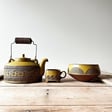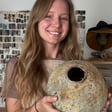
Mastering Sustainable Pottery with Christina Bendo
In this episode of Shaping Your Pottery, Christina Bendo, a woodfire potter, delves into her journey and expertise in the world of pottery. Christina discusses the commonly held belief in the pottery community that potters must endure extensive and laborious methods to achieve success, which she passionately disagrees with, advocating for more sustainable practices. She shares her own experiences, including her early inspiration from her fifth-grade art teacher, her impactful three-year assistantship with Trista Chapman, and her enriching residency at the International Ceramic Studio in Hungary. Christina emphasizes the importance of sustainable work practices, finding one's voice, and continuously pushing creative boundaries. She also speaks on the value of community, particularly within the wood firing process, and offers advice to budding potters on discovering their unique voices. You can learn more about christina by checking out her instagram https://www.instagram.com/christinabendopottery/
The Questions we ask will determine how our pottery will look like that's why I created a Free 15 questions to help you discover your voice template go grab it here www.shapingyourpottery.com/questions
Join the Clay Games Community to connect with like minded potters and compete in monthly pottery competitions Join Here
00:00 Introduction and Initial Thoughts 00:09 Challenging Traditional Pottery Beliefs 01:46 Sustainable Pottery Practices 03:17 Christina's Pottery Journey 05:36 Assistantship with Trista Chapman 09:49 Residency at the International Ceramic Studio in Hungary 15:40 Developing a Unique Pottery Style 19:25 The Appeal of Wood Firing 29:27 Finding Community in Wood Firing 33:02 Advice for Aspiring Potters 35:40 Final Thoughts and Farewell







